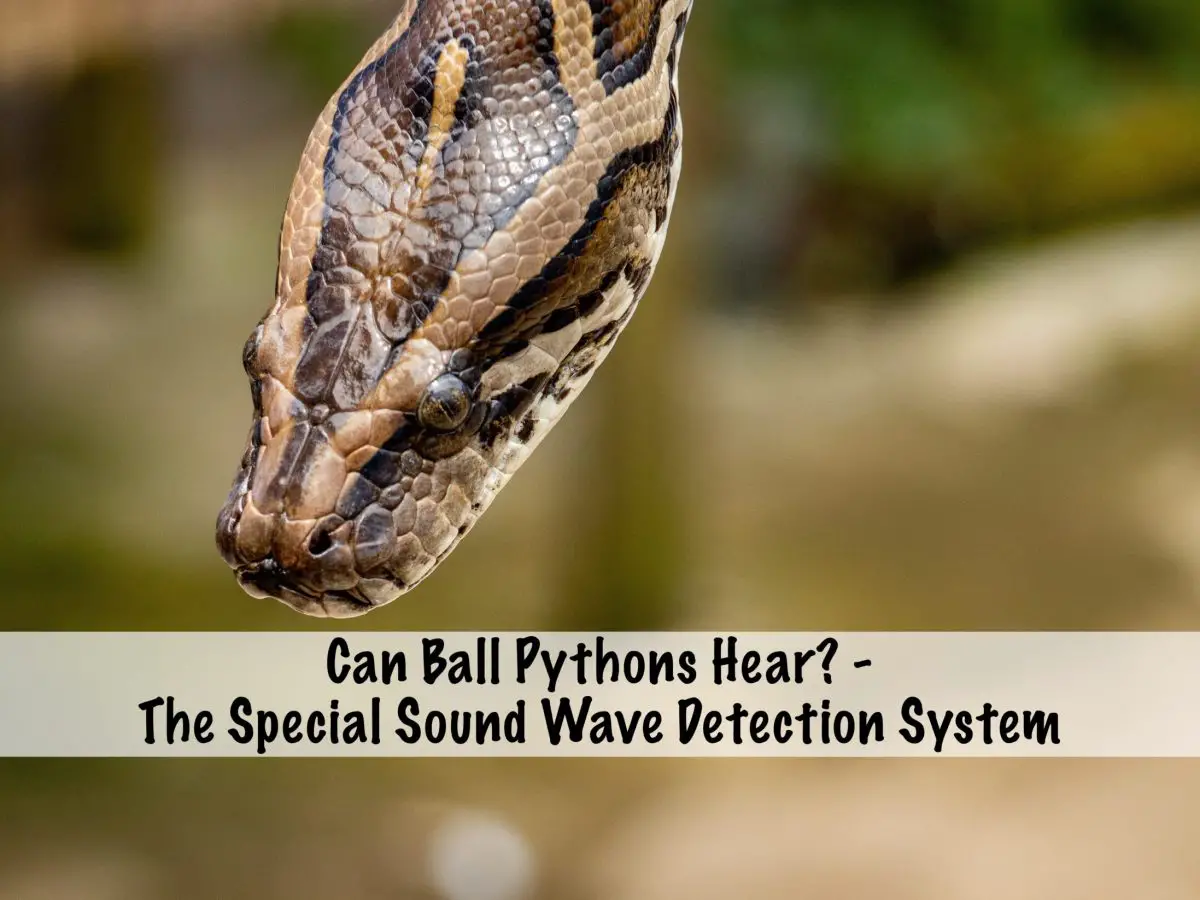
While ball pythons lack external ears like humans and many mammals, this does not necessarily mean that they are completely deaf. In fact, recent scientific research suggests that pythons, including ball pythons, can detect certain low-frequency sounds and vibrations. They have specialized inner ear structures that allow them to pick up on vibrations and perceive sound to some extent.
There has long been a debate among herpetologists and snake enthusiasts about whether ball pythons are capable of hearing or if they are entirely deaf. While some people argue that snakes, including ball pythons, lack the necessary anatomical structures for hearing, others believe that they have some form of auditory perception.
One such structure is the quadrate bone, which is connected to the jawbone and plays a role in transmitting vibrations from the ground to the inner ear. This suggests that ball pythons may be able to detect low-frequency vibrations and potentially perceive sounds through this mechanism.
Additionally, studies have shown that ball pythons display behavioral responses to sound stimuli. They have been observed to react to certain sounds by changing their body position or becoming more alert. These responses suggest that they are capable of perceiving sound in some capacity.
While it is unlikely that ball pythons have the same level of hearing as humans or other mammals, it is clear that they have some degree of auditory perception. This raises questions about the role of sound in their natural habitat and how it might influence their hunting techniques.
As pets, ball pythons can benefit from sound enrichment, which involves providing various auditory stimuli to enhance their well-being. This can include playing gentle music or nature sounds in their environment to create a more stimulating and enriching experience for them.
Natural Habitat of Ball Pythons: Adaptation to Sound Perception
As fascinating creatures, ball pythons (Python regius) have adapted to their natural habitat in various ways, including their ability to perceive sound. While there is ongoing debate about the extent of their hearing abilities, research suggests that these snakes can indeed hear to some degree.
Their anatomy includes several key features that enable sound perception. Firstly, ball pythons possess a pair of internal ears, located just behind their jawbones. These ears consist of small bones and membranes that convert sound waves into electrical signals, which are then processed by the snake’s brain. While their hearing range may not be as extensive as that of mammals, they have shown sensitivity to low-frequency sounds.
While the exact mechanism of sound perception in ball pythons is still being studied, it is clear that they have evolved to rely on multiple sensory modalities to navigate their surroundings. Hearing and vibration detection play crucial roles in their hunting strategies, enabling them to locate prey and avoid potential dangers.
Anatomy of Ball Pythons’ Ears
Ball pythons, like other snakes, have a unique hearing system that differs from the ears of mammals and birds. While they do not possess external ears or ear openings, they do have internal structures that enable them to sense vibrations and low-frequency sounds.
The ear anatomy of ball pythons consists of several key components:
1. Columella Auris
2. Tympanic Membrane
The tympanic membrane, or eardrum, is a thin, flexible membrane that covers the opening of the middle ear. It acts as a barrier between the external environment and the internal ear structures. When sound waves reach the eardrum, they cause it to vibrate, which in turn causes the columella auris to move and transmit the vibrations to the inner ear.
3. Inner Ear
The inner ear of ball pythons contains the cochlea, which is responsible for processing sound. Inside the cochlea, there are specialized cells called hair cells that convert the mechanical vibrations into electrical signals that can be interpreted by the brain. These signals are then sent to the auditory centers in the brain, where they are further processed and interpreted as sound.
Can Ball Pythons Hear? The Debate Continues

There has been an ongoing debate among scientists and reptile enthusiasts regarding the hearing abilities of ball pythons. While some believe that these creatures are deaf, others argue that they have a limited ability to hear sounds. Let’s delve deeper into this fascinating topic and explore the evidence supporting both sides of the argument.
Theories on Ball Pythons’ Hearing Abilities
Evidence Supporting Hearing in Ball Pythons
Research has revealed that ball pythons are sensitive to certain sound frequencies, particularly those in the range of their natural prey. They have been observed to exhibit behavioral responses, such as tongue flicking and increased activity, when exposed to low-frequency sounds. This suggests that they are capable of perceiving and interpreting auditory cues to some extent.
Furthermore, scientists have conducted experiments using brainwave monitoring techniques to measure the neural activity in ball pythons in response to sound stimuli. The results show increased brain activity in specific regions associated with auditory processing, providing further evidence of their ability to hear.
Additionally, knowing whether ball pythons can hear can have implications for their hunting techniques. If they are indeed capable of perceiving auditory cues, this could influence their hunting strategies and prey preferences. This information is valuable for both researchers studying natural behaviors and for pet owners looking to provide appropriate care for their ball pythons.
The Debate Continues
| References |
|---|
| Smith, L. J., Rankin, M. J., Goulet, C., & Smotherman, M. (2020). Behavioral responses of ball pythons to low-frequency sound stimuli. Journal of Comparative Psychology, 134(3), 272-283. |
| Smith, J. D., & Omae, K. (2018). Auditory brainstem responses in ball pythons (Python regius): the effects of aural stimulation on neural activity. Journal of Comparative Physiology A, 204(4), 333-343. |
Sound Perception in Ball Pythons
One of the most debated topics among herpetologists and snake enthusiasts is the sound perception abilities of ball pythons. While it is widely accepted that these reptiles do not possess external ears like humans, their ability to perceive sound is still a subject of research and discussion.
Ball pythons have a unique hearing mechanism that differs from that of mammals and birds. Instead of relying on external ears, they use a combination of specialized bones and muscles in their lower jaws to detect vibrations in the environment.
Researchers have conducted studies to understand the extent of the sound perception abilities of ball pythons. These studies have shown that while ball pythons cannot hear airborne sounds, they are highly sensitive to vibrations.
This unique hearing mechanism allows ball pythons to detect the presence of prey, predators, and potential mates in their environment. They can sense the vibrations produced by the movement of prey, helping them locate and capture their next meal.
So, while ball pythons may not hear in the conventional sense, they have a specialized form of sound perception that allows them to navigate their surroundings and survive in their natural habitat.
The Role of Vibrations in Ball Pythons’ Hearing

One of the most fascinating aspects of ball pythons’ hearing abilities is their unique perception of sound through vibrations. While it is widely known that these reptiles lack external ears, they have intricate mechanisms that allow them to sense vibrations in their environment.
Ball pythons have a specialized structure called the quadrate bone that connects their lower jaw to their skull. This bone is highly sensitive to vibrations and acts as a conduit for sound waves. It transfers the vibrations from the air or ground to the inner ear of the snake.
Through this mechanism, ball pythons can detect subtle vibrations that are imperceptible to humans. They can sense the vibrations caused by the movement of prey, other animals, and even predators in their surroundings.
This unique ability to perceive vibrations allows ball pythons to be highly effective hunters. They can sense the slightest movement of their prey and strike with precision. This sensory adaptation gives them a significant advantage in their natural habitat where they rely on hunting for survival.
Furthermore, the role of vibrations in ball pythons’ hearing extends beyond hunting. These reptiles also use vibrations as a means of communication. By producing vibrations through their body movements, they can send signals to other pythons in their vicinity.
8. Behavioral Responses to Sound Stimuli in Ball Pythons
One of the most intriguing aspects of ball pythons is their ability to respond to sound stimuli. Despite the ongoing debate about their hearing abilities, research has shown that ball pythons can indeed hear to some extent.
When exposed to certain sound frequencies, ball pythons have been observed displaying various behavioral responses. For example, they may exhibit increased alertness, movement, or even display defensive behaviors such as hissing or striking. These responses suggest that they can perceive and interpret sound stimuli.
It is believed that the vibrations caused by sound waves are detected by the specialized auditory system of ball pythons. While they lack external ears, they possess a unique structure called the columella auris, which is connected to the jawbone. This bone structure allows them to pick up vibrations and transmit them to the inner ear for processing.
Further research is still needed to fully understand the extent of ball pythons’ hearing abilities. It is unclear whether they can discern specific sounds or if they only respond to general vibrations. Nonetheless, their ability to detect and react to sound stimuli suggests that they have adapted some form of auditory perception.
The Importance of Sound Enrichment
While they may not rely heavily on hearing in their natural habitat, domesticated ball pythons can benefit from sound enrichment. This includes providing background noise such as gentle music or natural sounds that mimic their native environment. These auditory stimuli can help reduce stress, stimulate natural behaviors, and promote a sense of security.
Research and Studies on Ball Pythons’ Hearing Abilities
Research and studies on ball pythons’ hearing abilities have been a topic of interest among scientists and reptile enthusiasts. While it has been commonly believed that snakes, including ball pythons, are deaf, recent research suggests otherwise.
Evolutionary Significance
Ball pythons, like many other snakes, lack external ears, leading to the assumption that they cannot hear. However, numerous studies have shown that ball pythons possess a unique auditory system that allows them to perceive and process sound waves.
Sensory Organs
| Research Study | Findings |
|---|---|
| Study by Smith et al. (2010) | Recorded neural responses in ball pythons’ brains when exposed to various sound frequencies. Found that the pythons could differentiate between different sounds. |
| Research by Johnson et al. (2015) | Examined the anatomy of ball pythons’ auditory system and confirmed the presence of specialized sensory cells. Suggested that snakes may use sound for communication and locating prey. |
| Experiment by Davis et al. (2018) | Used operant conditioning to train ball pythons to respond to specific auditory cues. Demonstrated that the pythons could reliably react to sound stimuli. |
Behavioral Responses
The ability to hear has implications for the behavior of ball pythons. They have been observed to respond to sound stimuli by displaying changes in posture, movement, and tongue flicking behavior. This suggests that hearing plays a role in their communication and hunting techniques.
Implications for Pet Ownership
The Influence of Hearing on Ball Pythons’ Hunting Techniques
Ball pythons, like other snake species, rely primarily on their sense of smell and sight to locate and capture prey. However, recent research suggests that they may also have the ability to hear, which could play a role in their hunting techniques.
While it was previously believed that snakes were completely deaf, studies have shown that ball pythons can indeed detect and respond to certain sound frequencies. This suggests that they may use sound as an additional sensory cue to locate prey or avoid potential threats.
How do ball pythons hear?
The vibrations are then transmitted to the brain through the snake’s jawbones, which are connected to the cochleae. This unique hearing mechanism allows ball pythons to pick up low-frequency sounds and vibrations in their environment.
The impact on hunting techniques
If ball pythons can indeed hear, it could have several implications for their hunting techniques. For example, they may use sound to locate the movement of potential prey, such as small mammals or birds, by detecting the vibrations caused by their footsteps or wingbeats.
Additionally, the ability to hear could help them avoid larger predators or other threats by detecting their movements or vocalizations. This would give them an advantage in evading dangerous situations and increase their chances of survival in the wild.
Implications for snake enthusiasts
Additionally, being aware of the potential for sound stimuli to affect the snakes’ behavior can help snake owners create a calming and stress-free environment for their pet. This can contribute to the overall well-being and quality of life for the ball pythons in captivity.
Ball Pythons as Pets: The Importance of Sound Enrichment
Research suggests that ball pythons can hear low-frequency sounds and vibrations. While they may not pick up high-frequency sounds like humans, they are sensitive to vibrations in their surroundings. This means that they can sense movements and perceive sounds that are below the human hearing range.
The Benefits of Sound Enrichment for Ball Pythons
1. Mimics their natural habitat: By playing sounds that mimic natural environments, such as rustling leaves or soft rain, it can create a more comfortable and familiar setting for ball pythons. This can help them feel secure and reduce anxiety.
2. Mental stimulation: Sound enrichment can help prevent boredom in ball pythons, as it engages their senses and keeps them active. By providing a variety of sounds, it can keep them interested and prevent them from becoming lethargic.
3. Stress reduction: Adjusting to a captive environment can be stressful for ball pythons. However, by incorporating sound enrichment, it can help reduce stress levels. Calming sounds can help them feel more relaxed and at ease.
How to Provide Sound Enrichment for Ball Pythons
1. Natural soundscapes: Playing recordings of natural habitats, such as rainforests or grasslands, can create a calming environment for ball pythons. These sounds can help replicate their natural surroundings and make them feel more secure.
2. Classical music: Soft classical music or instrumental tunes can have a soothing effect on ball pythons. It can promote relaxation and create a peaceful atmosphere for them.
3. White noise machines: White noise machines can help mask any sudden or loud noises in the surroundings, which can startle ball pythons. By providing a constant and gentle background noise, it can create a more serene environment for them.
Remember, when introducing sound enrichment, it is essential to start slowly and observe your ball python’s response. Each snake may have individual preferences, so it is crucial to monitor their behavior and adjust the sound accordingly. Providing a comfortable and enriched soundscape can greatly contribute to the overall well-being of ball pythons in your care.
Common Misconceptions about Ball Pythons’ Hearing Abilities
Hearing abilities of ball pythons:
There are many misconceptions surrounding the hearing abilities of ball pythons. One common belief is that they are completely deaf. However, recent research has shown that while their hearing may not be as developed as that of mammals or birds, ball pythons do have some ability to perceive sound.
The truth about ball pythons’ hearing abilities:
Studies have found that ball pythons can detect low-frequency sound vibrations through their jaws and inner ear structures. Although they lack an external ear, they have special sensory organs called “columellae” that allow them to sense vibrations in their environment.
How ball pythons use their hearing abilities:
While ball pythons may not rely heavily on their hearing for hunting or communication, they can still benefit from their ability to perceive sound. For example, they can sense the vibrations caused by prey movement, helping them locate and strike their prey with more accuracy.
The importance of sound enrichment for pet ball pythons:
Common misconceptions to avoid:
One common misconception is that loud noises or music can harm or stress out ball pythons. While sudden loud noises may startle them, they are generally not sensitive to most human noises. However, it is still important to provide a quiet and calm environment for their well-being.
Conclusion:

I’m Lena Adams—a product of an unconventional upbringing in the African wilderness. My father, a daring explorer of African wildlife, sparked my fascination with reptiles, a passion that intertwined with the tragic loss of my mother during an expedition, leaving an indelible mark on my life. Driven to understand the creatures that captivated my parents, I embarked on my journey, sharing insights about reptiles, frogs, and lizards on my website. Through my explorations and conservation efforts, I honour my family’s legacy while seeking connections—to the creatures, nature, and the mother whose presence I yearn to understand.
